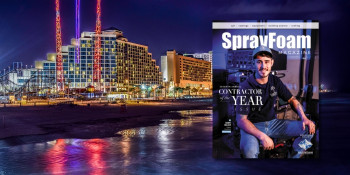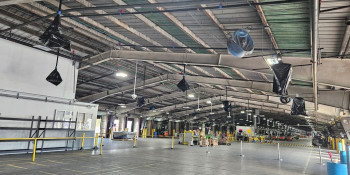Q&A Forums
QUESTION REGARDING FIRE CONCERNS!! Post New Topic | Post Reply
| Author | Comments |
|---|---|
|
Gianni Latona
Posted: Feb 08, 2011 06:16 PM
|
QUESTION REGARDING FIRE CONCERNS!!
I had a client approach me today and saw some open cell spray foam being hit by a torch flame and is extremely concerned with the toxicity and the ignition speed of foam. How has anyone here handled such questions- We all know there needs to be dry wall over foam or a 15 minute ignition barrier, but lets face it todays consumer is not so easy to please or persuade. This is extremely important and there should be more research into improving flame resistant/fire resistant in our foams.Thanks to all that always reply!!! |
|
Posted: Feb 08, 2011 08:00 PM
|
...did he put the torch on the wood frameing??? did he put the torch on the wood sheeting??? did he put the torch on the filterglass?? did he put the torch on the tyvek?? on the vinyl siding?? on the pex tubing on the shower enclosures on the pvc (thats polyvinylbaby) on the flooring on the carpet on the blow in on the paints the friggin sky is falling!!!! look at these folks and smile and say yes,,,if your house is on fire,,you better get the heck out...foam or no foam.. right jim? |
|
Gianni Latona
Posted: Feb 08, 2011 08:13 PM
|
I agree with you one hundred percent! |
|
Daniel X
Posted: Feb 09, 2011 12:53 AM
|
foamdude, I guess it's a good thing you don't do any commercial work then. Where I work the foam is about the only thing that actually will burn... |
|
Posted: Feb 09, 2011 03:49 AM
|
(dll,,,mostly residential by choice,, get in,,get out,,get your check,,) |
|
Gianni Latona
Posted: Feb 09, 2011 06:39 AM
|
Foam dude, i really dont believe thats the proper way of addressing concerns of people. In the end all contractors have some responsibility to disclaim pros and cons, we just need the right answers. |
|
mason
Posted: Feb 09, 2011 01:30 PM
|
Foam is combustible and will burn just like hundreds of other building products. However sprayfoam burns differently than other products such as wood. Initially the surface of the foam can ignite which can lead to flash fire. But the char formed on the foam surface as it burns is fire retardent and can in many cases prevent the spread of fire and smoke to other rooms or areas separate by walls or ceilings. There are tests conducted on assemblies that are used to determine how to install a specific foam plastic in a particular situation. Check out the ICC Evaluation report for the product and it will tell how it can be installed and be compliant to the codes and with an acceptable level of risk. |
|
jimcoler
I have over 10 years of experience specifying and installing open and closed cell spray foam. I've sold my business but I'm still selling for the new owners and consulting on large and custom specific jobs. I've expanded my knowledge into t Posted: Feb 10, 2011 07:54 AM
|
Dude said it! What about testing other products right along side of the foam? How about your lazy boy chair that people fall asleep in almost every night - some smoking cigarettes? You bet that woudl get their attention! I as a fireman and an Asst Chief know that the contents of the room are far more likely to kill you than the foam insulation will. What about the carpet? Paint? Curtains? Wall coverings? What about the non combustible metal studs? They won't burn, but they will warp and possibly collapse once the contents of the building get going. The other thing is how was it tested? We all should know that holding a torch to the material is not a valid test but has been done many times. I've done it and enjoy watching the foam burn when the torch is on it. Then when you remove the torch, the flame will go out. Yes, it does have a flash over point, but that's above 400F and anything inside shoudl get the heck out immediately. So, what doesn't have a flash over point? As far as commercial buildings, yes the foam is one of the only products used which is considered combustible. But Kraft faced fiberglass is just as combustible as shown in the SWRI Attic and Crawlspace test. But Fiberglass is considered non-combustible!!! How does that happen? Go figure! I've seen many commercial buildings with kraft faced fiberglass being left exposed in the attic space with HVAC ducts, furnaces, and other mechanical equipment up there without any covering!! Almost every building I go in has this! Start checking them out! Check behind the non fire rated drop ceiling? Do you see kraft faced fiberglass? That's a big No-NO according to the code and even the fiberglass industry admits it. They write it right on the face of the kraft facing! In addition to all of this, they do have standards to test the products in fire situations. I don't always agree with them as many of them seem over amplified with the equivalent of 3 of the largest gas grills from home depot stacked on top of each other in the corner and lighting it off (40kW). Then bump that up to 4 times that after 5 minutes (160kW). That's the NFPA 286 test in a nut shell but the NFPA 286 test in AC-377 is only the first half of this test (40kW) even though their calling it the NFPA 286 test in some cases. SO, yes there can be concerns aroused up by competitors but are they being tested realistically, and side by side iwth other products like their lazy boy chair? Hope this helps. Jim |
|
JohnPeters
Posted: Feb 11, 2011 08:13 AM
|
I am done trying to fight this topic. I hate to say it gentleman, but I think we need to give in and embrace the direction our industry is moving. We all have family, your kids, mom, sister and uncle Larry who still can't find a job. At the end of the day we need to ask ourselves, if any of our loved ones was living in a house that was conventionally insulated (batts in the attic floor) vs. foam in the roof rafters covered with an ignition or thermal barrier - the foam and coating would be the safer choice from a fire perspective. We need to start looking at ourselves as not only insulators, but fire protection contractors. Not only are we providing more energy efficient and comfortable living conditions for building occupants, we're also providing a safer fire and combustive environment with the use of these coatings. Foam is plastic, when plastic is burned it gives off noxious fumes. Its not the flames that kill you in a house fire, its the smoke. When these coating regulations were released it was like the sky was falling. Well, when life gives you lemons, make some lemonade. We're all small business owners, we have to be adaptive, look for the silver lining. Find a weakness or a strength and exploit it. Adapt and overcome my friends. |
|
John Shockney
Posted: Feb 11, 2011 10:54 AM
|
There is nothing in the construction industry that is completely fireproof except maybe concrete or brick. The wood framing burns. The paper and paint on fire rated sheetrock burns. Even the steel in commercial buildings will burn under the right conditions just take a match to some 0000 steel wool or cut a piece of steel with a torch and after you start adding O2 turn off the acetylene and keep on cutting that's the steel burning creating the heat to keep cutting. We cannot reduce the fire danger to nothing so the best fire protection plan is to alert and give the people inside as much time as possible to get out. Most schools and public buildings require that the walls and doors leading into the hallways be one hour fire rated to provide an escape route that won’t be blocked be a fire. So if spray foam is installed behind the walls, ceilings or floors with fire alarms and escape routes the building should be as “safe” or “safer” than another building built under today’s code standard. This requires the designer and builder do their part not the guy spraying foam. Also today penetrations through floors and ceilings inside walls are being required to be sealed with “fire calk” or “fire rated caned foam” to stop fire from spreading from floor to floor or the chimney effect that can happen inside the wall. Because these “fire calks” are the same plastics that are in spray foam the use of them is not required in walls insulated with spray foam but is required with fiberglass and cellulose. How’s that for a contradiction!!! Airpro |





























